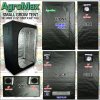blaze13
Member
Hey ppl this is my first grow. Got most of my stuff today at local hydro store. Im doing a one site scrog in a small tent, GH Waterfarm, 400W CMH. The tent is 63"H X 36"W X 22"D. The tent is up and the light is in, now I'm trying to figure out what I want to do to cool the damn thing. I bought a honkin 4" inline fan with carbon filter to vent hot air out the 4" hole at the top rear of the tent. Im thinking its a little overkill for one plant and this size of tent, plus i'll have to mount it somewhere behind the tent and the whole rig sticks like 18" inches out the freakin back.
I did a trial run with the lamp on and the top 6" flap open to vent hot air (no fans). The bottom flap was also open. The ambient temp of my basement is around 58 degrees this time of year. Within an hour the temp was up to 94 in the tent. Seems to be stabilizing around 95, pretty toasty. So ya, I need some definite ventilation domination.
So here's where my options come in for you knowledgeable folks. I have have two 6" holes on the sides of the tent intended for cooling the lamp/reflector, there's another 6" on the top, and a 4" on the back wall. There's a large intake flap at the bottom with another 4" hole beside it. I'll post a picture of the tent below so you can see what I'm working with.
I'd really like to stick with the open air reflector if possible, that's why i tried to get around using the ducting and cooling fans. What about a couple intake fans? Do I need to exhaust the air at all?

I did a trial run with the lamp on and the top 6" flap open to vent hot air (no fans). The bottom flap was also open. The ambient temp of my basement is around 58 degrees this time of year. Within an hour the temp was up to 94 in the tent. Seems to be stabilizing around 95, pretty toasty. So ya, I need some definite ventilation domination.
So here's where my options come in for you knowledgeable folks. I have have two 6" holes on the sides of the tent intended for cooling the lamp/reflector, there's another 6" on the top, and a 4" on the back wall. There's a large intake flap at the bottom with another 4" hole beside it. I'll post a picture of the tent below so you can see what I'm working with.
I'd really like to stick with the open air reflector if possible, that's why i tried to get around using the ducting and cooling fans. What about a couple intake fans? Do I need to exhaust the air at all?

